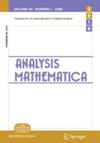不变子空间和群逆上线性关系的限制
IF 0.5
3区 数学
Q3 MATHEMATICS
引用次数: 0
摘要
本文将考虑线性关系不变子空间的两个概念:第一个概念是通过线性关系的图,第二个概念是利用线性关系的解析函数。通过算例和初步结果表明,当涉及到线性关系的谱性质时,第二种概念更为适用。在本文的第二部分,允许这样一个不变子空间的概念,以建设性的方式发展了线性关系的群逆的概念。本文章由计算机程序翻译,如有差异,请以英文原文为准。
Restrictions of linear relations on invariant subspaces and group inverse
In this paper, we will consider two notions of an invariant subspace for a linear relation: the first one is through the graph of a linear relation, and the second one is by using the resolvent function of a linear relation. Through some examples and preliminary results, it is shown that the second notion is more suitable when the spectral properties of liner relations are involved. In the second part of the paper, such a notion of an invariant subspace is allowed to develop, in a constructive way, the concept of group inverse for linear relations.
求助全文
通过发布文献求助,成功后即可免费获取论文全文。
去求助
来源期刊

Analysis Mathematica
MATHEMATICS-
CiteScore
1.00
自引率
14.30%
发文量
54
审稿时长
>12 weeks
期刊介绍:
Traditionally the emphasis of Analysis Mathematica is classical analysis, including real functions (MSC 2010: 26xx), measure and integration (28xx), functions of a complex variable (30xx), special functions (33xx), sequences, series, summability (40xx), approximations and expansions (41xx).
The scope also includes potential theory (31xx), several complex variables and analytic spaces (32xx), harmonic analysis on Euclidean spaces (42xx), abstract harmonic analysis (43xx).
The journal willingly considers papers in difference and functional equations (39xx), functional analysis (46xx), operator theory (47xx), analysis on topological groups and metric spaces, matrix analysis, discrete versions of topics in analysis, convex and geometric analysis and the interplay between geometry and analysis.
 求助内容:
求助内容: 应助结果提醒方式:
应助结果提醒方式:


